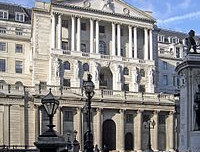
OVERVIEW
MANAGEMENT
PERFORMANCE
POSSIBILITIES
CAPITALS
ACTIVITIES
ACTORS
BURGESS
|
FINANCIALIZATION
QUANTITATIVE EASING (QE) Bank of England’s Covid money-printing spree ‘drove up inflation’ ... Experts claim quantitative easing is partly to blame for double-digit price rises 
Original article: https://www.telegraph.co.uk/business/2023/04/18/bank-of-england-covid-money-printing-drove-up-inflation/ Peter Burgess COMMENTARY Peter Burgess | ||
|
Bank of England’s Covid money-printing spree ‘drove up inflation’
Experts claim quantitative easing is partly to blame for double-digit price rises Written by Eir Nolsøe 18 April 2023 • 12:34pm The Bank of England helped to trigger double-digit inflation by launching a money-printing spree during the Covid crisis, economists have claimed. Experts said that Threadneedle Street stoked price rises by pumping £450bn into the economy during the pandemic. Andrew Sentance, a former rate-setter at the Bank, told MPs on the Treasury Select Committee that a combination of ultra-low interest rates and quantitative easing (QE) – where electronic money is created and used to buy bonds – “quite significantly contributed to the inflation we're now experiencing.” He said: “We had this long period of extremely low interest rates and further injections of QE after the immediate problems and the financial crisis have passed. “That all I think has contributed over a period of time to the inflationary pressures that we're now seeing.” Prices rose by 10.4pc in the year to February, with the UK experiencing the highest inflation rate of any large advanced economy. 
Mr Sentance said: “It did seem that the QE went on for too long. “We had a more than doubling of the amount of QE during the pandemic. And it wasn't clear that that was the appropriate policy at all.” His view was echoed by other economists giving evidence to the Committee. Katharine Neiss, chief European economist at PGIM Fixed Income who worked at the Bank for two decades, said: “QE is designed, and I'm persuaded by the evidence, to ease financial conditions, support the real economy and therefore push up on inflation. “And it has undoubtedly contributed to the inflation that we have seen over the last several years.” Ms Neiss warned, however, that assessing the extent to which quantitative easing has pushed up prices amid other pressures is very tricky. She said: “There are a lot of other things going on, not least higher energy prices and it is very difficult to unpick the impact of these.” Gerard Lyons, chief economic strategist at Netwealth and former advisor to the prime ministers Boris Johnson and Liz Truss, said that unlike previous crises which mainly affected demand, the pandemic increased inflation by restricting the supply of goods and services. The Bank's approach to money printing and interest rates during the pandemic did not help, he said. 
He said: “So what we had then was inflation taking hold both because of supply shocks and inappropriate monetary policy. “I do think it embedded inflationary pressures and I thought it was the wrong approach to take.” Jagjit S Chadha, director of the National Institute of Economic and Social Research, told the committee that he believed the decision to loosen monetary policy was probably correct, but added: “I think there are some questions as to whether we were too quick to turn to QE both after the result of the Brexit referendum and in the middle of Covid.” During the pandemic, the Bank of England cut interest rates to their lowest ever level of 0.1pc, keeping them there until December 2021. It created £450bn through quantitative easing in 2020 and 2021, bringing the total of value of its assets to a record £895bn. It began undoing this process in February this year. Business Briefing Newsletter
| The text being discussed is available at | and |